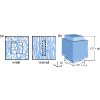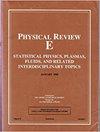仿射半柔性聚合物网络中的非线性泊松效应
IF 2.4
3区 物理与天体物理
Q1 Mathematics
引用次数: 0
摘要
沿着一条轴线拉伸弹性材料通常会引起横向轴线的收缩,这种现象被称为泊松效应。根据这些应变,我们可以计算出比容,比容通常会随着材料的拉伸而增大,或者在不可压缩极限下保持不变。然而,在半柔性或刚性聚合物网络中,这些聚合物通常具有很高的可压缩性,但在拉伸时会明显变硬,因此在有限应变下,比容反而会显著减小。伴随着体积减少的是沿应变轴的细丝排列越来越整齐,并出现非线性弹性反应,表观杨氏模量变硬。在半柔性网络中,熵弯曲弹性控制着线性弹性机制,而非线性泊松效应则是由组成丝的非线性力-拉伸关系引起的,它使组成聚合物对拉伸和压缩产生高度不对称的响应。这种关系的细节取决于底层细丝的几何和弹性特性,而这些特性在实验系统中会有很大差异。在此,我们对仿射网络模型中的非线性泊松效应进行了全面描述,并探讨了长丝特性对微观和宏观响应基本特征的影响,包括应变驱动的排列和体积缩小。本文章由计算机程序翻译,如有差异,请以英文原文为准。

Nonlinear Poisson effect in affine semiflexible polymer networks
Stretching an elastic material along one axis typically induces contraction along the transverse axes, a phenomenon known as the Poisson effect. From these strains, one can compute the specific volume, which generally either increases or, in the incompressible limit, remains constant as the material is stretched. However, in networks of semiflexible or stiff polymers, which are typically highly compressible yet stiffen significantly when stretched, one instead sees a significant reduction in specific volume under finite strains. This volume reduction is accompanied by increasing alignment of filaments along the strain axis and a nonlinear elastic response, with stiffening of the apparent Young's modulus. For semiflexible networks, in which entropic bending elasticity governs the linear elastic regime, the nonlinear Poisson effect is caused by the nonlinear force-extension relationship of the constituent filaments, which produces a highly asymmetric response of the constituent polymers to stretching and compression. The details of this relationship depend on the geometric and elastic properties of the underlying filaments, which can vary greatly in experimental systems. Here, we provide a comprehensive characterization of the nonlinear Poisson effect in an affine network model and explore the influence of filament properties on essential features of both microscopic and macroscopic response, including strain-driven alignment and volume reduction.
求助全文
通过发布文献求助,成功后即可免费获取论文全文。
去求助
来源期刊

Physical review. E
物理-物理:流体与等离子体
CiteScore
4.60
自引率
16.70%
发文量
0
审稿时长
3.3 months
期刊介绍:
Physical Review E (PRE), broad and interdisciplinary in scope, focuses on collective phenomena of many-body systems, with statistical physics and nonlinear dynamics as the central themes of the journal. Physical Review E publishes recent developments in biological and soft matter physics including granular materials, colloids, complex fluids, liquid crystals, and polymers. The journal covers fluid dynamics and plasma physics and includes sections on computational and interdisciplinary physics, for example, complex networks.
 求助内容:
求助内容: 应助结果提醒方式:
应助结果提醒方式:


